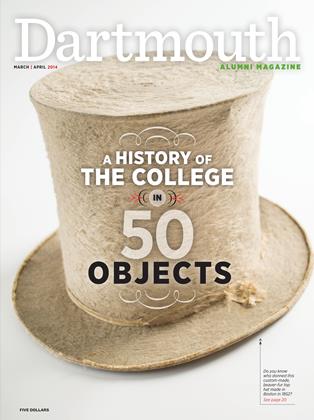Images and drawings dating back to 1840 depict the Green edged with a magnificent canopy of American elm trees, earning Dartmouth the nickname “The College of a Thousand Elms.” But the trees’ close proximity to each other led to disaster when Dutch elm disease arrived in the 1950s. The College cut 11 diseased elms in 1951, and by the 1980s Dartmouth had lost more than 200 elms. Roughly 150 remain on campus and town streets. Last year a 140-year- old giant elm succumbed to root rot, and the Collis elm was taken down in 2012 because of decay in the trunk. In 2011 the Parkhurst elm was also removed due to an insect infestation. Since the 1990s the oldest elms have been treated with preventive fungicide injections, and several dozen young, disease- resistant elms are added to the College’s tree nursery each year. According to campus arborist Brian Beaty, Dartmouth continues to plant elm trees because, in addition to their historical significance, desirable form and superior architecture, American elms are usually tolerant of urban growing conditions.
 View Full Issue
View Full Issue
More From This Issue
-
 Cover Story
Cover StoryABBEY D’AGOSTINO’S RACING SPIKES
March | April 2014 -
 Cover Story
Cover StoryJOHN RASSIAS’ EGG
March | April 2014 -
 Cover Story
Cover StoryPIECE OF WOOD FROM MOLLY BLACKBURN HALL
March | April 2014 -
 Cover Story
Cover StoryPEAVEY HEAD
March | April 2014 -
 Cover Story
Cover StoryLONE PINE
March | April 2014 -
 Cover Story
Cover StoryWEBSTER’S TOP HAT
March | April 2014
Features
-
 Feature
FeatureOutstanding Class Records on 1940 Alumni Fund
April 1941 -
 Feature
FeatureThose First Happy, Day at Hectic Dartmount
NOVEMBER 1963 -
 Feature
FeatureNew Facilities in the Making
OCTOBER 1972 -
 Cover Story
Cover StoryThe Buddy System
OCTOBER • 1987 By Frank Cicero '85 -
 Feature
FeatureBurned
Nov/Dec 2011 By Jane Varner Malhotra ’90 -
 Feature
FeatureThayer School's Centennial
OCTOBER 1971 By WILLIAM P. KIMBALL '28

